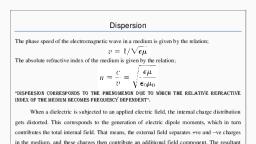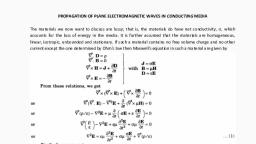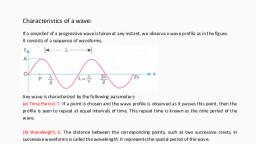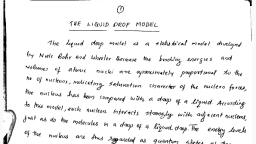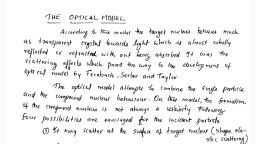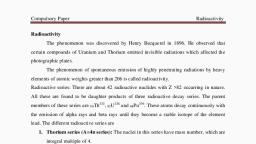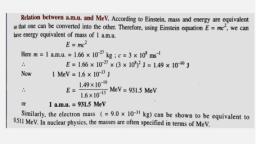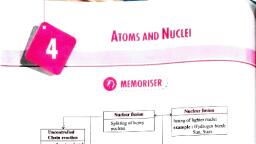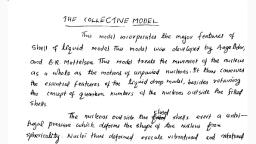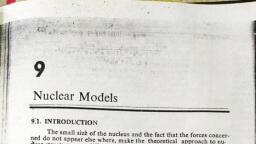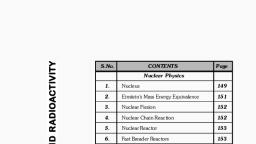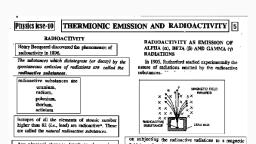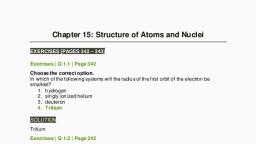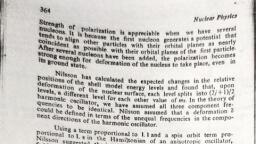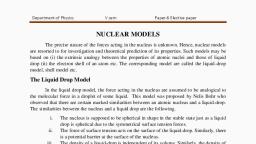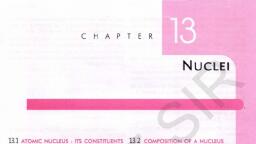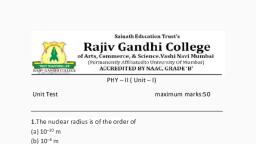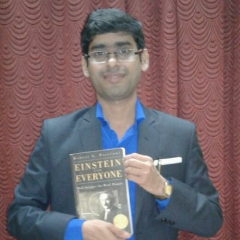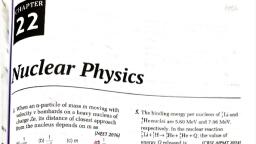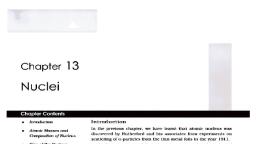Page 1 :
The liquid drop, The liquid drop model is a model in nuclear physics which treats the nucleus, as a drop of incompressible nuclear fluid, first proposed by George Gamow, and developed by Niels Bohr and John Archibald Wheeler. The fluid is, made of nucleons (protons and neutrons), which are held together by the, strong nuclear force., This is a crude model that does not explain all the properties of nuclei, but, does explain the spherical shape of most nuclei. It also helps to predict the, binding energy of the nucleus., Similarities between liquid drop and the nucleus:, 1. The nucleons are treated like molecules present in a liquid drop., 2. Both, , liquid, , drop, , and, , nucleus, , exhibit, , homogeneity, , and, , incompressibility. That means the charge density and all other, properties of the nucleus are uniform throughout the nucleus., 3. Both liquid drop and nucleus show surface tension effect. That means, the surface energy of the nucleus is analogous to the surface tension of, liquids., 4. Inter nucleon forces are similar to the intermolecular forces., 5. Evaporation in liquid drop is analogous to the loss of nucleons from, the nucleus in nuclear reactions., 6. K.E. of nucleons is analogous to the thermal agitation of the, molecules in a liquid drop.
Page 2 :
7. Fusion of small drops of liquid into a big drop and splitting of one big, drop into smaller drops are analogous to the nuclear fusion and, nuclear fission., , Weizsacker Semi-Empirical mass formula:, On the basis of liquid drop model, Weizsacker and others have attempted to, express the masses of nuclei in terms of nuclear characteristics in connection, with their binding energy and stability. This formula is known as semiempirical mass formula., Let M(A,Z) be the nuclear mass of the isotope of an element X of atomic, number Z and mass number A. Then;, M(A,Z) = ZMH + NMn - EB, Where MH and Mn are the masses of the hydrogen atom and neutron, respectively and EB is the nuclear binding energy. N=A-Z is the number of, neutrons present in the nucleus., One can express the binding energy EB as the sum of a number of terms as, given below:, , I) Volume energy: When an assembly of nucleons of the same size is, packed together into the smallest volume, each interior nucleon has, a certain number of other nucleons in contact with it. So, this, nuclear energy is proportional to the volume. The volume is
Page 3 :
directly proportional to the mass number A. Thus this volume, energy term is given by;, Ev = avA where av is a constant., II) Surface energy: A nucleon at the surface of a nucleus interacts with, fewer other nucleons than one in the interior of the nucleus and, hence its binding energy is less. This surface energy term takes that, into account and is therefore negative and is proportional to the, surface area. As the nuclear radius is proportional to A1/3, the, surface area is proportional to A2/3. The surface energy term is, represented by;, ES = -as A2/3 where as is a constant., III), , Coulomb Energy: The Coulomb repulsion between each pair of, protons in a nucleus contributes for decreasing the binding energy., As each proton is repelled by (Z-1) protons, the total Coulomb, energy is proportional to Z(Z-1)e2/R., , The term, , is known as the Coulomb or electrostatic term., , The basis for this term is the electrostatic repulsion between protons. To a, very rough approximation, the nucleus can be considered a sphere of, uniform charge density. The potential energy of such a charge distribution, can be shown to be
Page 4 :
where Q is the total charge and R is the radius of the sphere. Identifying Q, with Ze, and noting as above that the radius is proportional to A1 / 3, we get, close to the form of the Coulomb term. However, because electrostatic, repulsion will only exist for more than one proton, Z2 becomes Z(Z − 1). The, value of aC can be approximately calculated using the equation above:, Empirical nuclear radius:, , Quantum charge integers:, , Integration by substitution gives:, , Potential energy of charge distribution:, , Electrostatic Coulomb constant:, , The value of aC using the fine structure constant:
Page 5 :
where α is the fine structure constant and r0A1 / 3 is the radius of a nucleus,, giving r0 to be approximately 1.25 femtometers. This gives aC an, approximate theoretical value of 0.691 MeV, not far from the measured, value., , IV), , Asymmetry energy: We have seen that maximum stability occurs, when Z=A/2 ie., if the number of protons is equal to the number of, neutrons. But when the number of neutrons is higher than Z,, instability of the nuclide appears. This is known as asymmetry or, composition effect. Since the excess neutrons occupy the higher, quantum states than the other nucleons, they contribute a smaller, amount to the binding energy. Hence this term causes for the, reduction in the binding energy. This energy is proportional to the, square of the neutron excess and inversely to mass number ie.,, Ea = -aa (A-2Z)2/A where aa is the proportionality constant., , V) Pairing energy: An energy which is a correction term that arises, from the tendency of proton pairs and neutron pairs to occur. An, even number of particles is more stable than an odd number., The term δ(A,Z) is known as the pairing term (possibly also known as the, pairwise interaction). This term captures the effect of spin-coupling. It is, given by:
Page 6 :
where, , Due to Pauli exclusion principle the nucleus would have a lower energy if, the number of protons with spin up will be equal to the number of protons, with spin down. This is also true for neutrons. Only if both Z and N are even,, both protons and neutrons can have equal numbers of spin up and spin down, particles. This is a similar effect to the asymmetry term., Thus we have,, M ( A, Z ) ZM H ( A Z ) M n av A as A2/ 3 ac, , Z ( Z 1), ( A 2Z ) 2, , a, , a, A1/ 3, A, , The values of coefficients considered in the mass formula according to the, calculations of Green are:, av = 15.75 MeV, as = 17.8 MeV, ac = 0.71 MeV,, aa = 23.70 MeV and ap = 33.5 MeV.
Page 8 :
Applications of the Semi empirical mass formula:, I Stability of isobars:, Using the semi empirical mass formula, one can find the most stable isobar., We have the semi empirical mass formula;, M ( A, Z ) ZM H ( A Z ) M n av A as A, , 2/ 3, , Z ( Z 1), ( A 2Z ) 2, ac, aa, ------(I), A1/ 3, A, , Differentiating the above equation omitting the pairing term, wrt Z and, equating it to zero, we have:, (, , M, 2Z, A 2Z, ) constA M H M n ac 1 / 3 4aa, 0, Z, A, A, , If Z=Z0 satisfies the above relation, then, 2ac, , Z0, A 2Z 0, 4aa, Mn MH, 1/ 3, A, A, , and, ( M M ) 4aa , Z 0 n 2 / 3H, A . -----------(II), 2ac A 8aa , , Given the data, Mn = 939.550 MeV and MH = 938.767 MeV, we get the, charge number Z0 = 43.8 for the stable isobar with A=101.Thus the nucleus, with Z0 = 44 is the most stable isobar for A=101., Omitting the pairing term, the equation (I) which is a quadratic in Z can be, written as, M(Z,A) = αA+βZ+γZ2 -----------------(III), with α = Mn-av+aa+as/A1/3 ; β = MH-Mn-4aa and γ= acA-1/3+4aa/A., Equation (III) is a quadratic in Z and hence yields a parabola for the curve, connecting M(A,Z) and Z for constant A. Such parabolae are shown below.
Page 9 :
Figure 2.4: The curve showing the parabolic relationship between the masses of odd-A, isobars. The zero-point on the energy scale is arbitrary and A = 101., , Figure 2.5: Curves showing the parabolic relationship between the masses of even-A, isobars. The zero-point on the energy scale is arbitrary and A = 106.
Page 11 :
II Energy released during Nuclear fission:, When heavy nuclei are bombarded by neutrons, it is found that they split, roughly into two halves with the emission of two or more neutrons. This, phenomenon is known as nuclear fission and it was first discovered by Hahn, and Strassmann in the year 1938. Let us consider the spontaneous symmetric, fission of 236U92 and calculate the energy released using the Weizsacker, semi-empirical mass formula (I)., Q = M(A,Z) – 2M(A/2,Z/2), = 2B(A/2,Z/2) – B(A,Z) ----------------(IV), The Q value can easily be calculated using the semi empirical mass formula., As we are considering the binary symmetric fission, volume term and, asymmetry term do not contribute to the Q value. Also, neglecting the, pairing term we obtain;, Q 2as A / 2 , , A / 2 as A2 / 3 ac Z 2 A1/ 3, 1/ 3, 2 / 3, ----------------(V), as A2 / 3 1 2 ac Z 2 A1/ 3 1 2 , 2/3, , 2ac Z / 2 , , 2, , 1/ 3, , 0.26as A2 / 3 0.37ac Z 2 A1/ 3 ., , In the above equation substituting the values as=17.8 MeV and ac=0.71, MeV, the Q value for 236U92 comes out to be, Q=183.78 MeV., This is the energy released per fission of 236U92.

